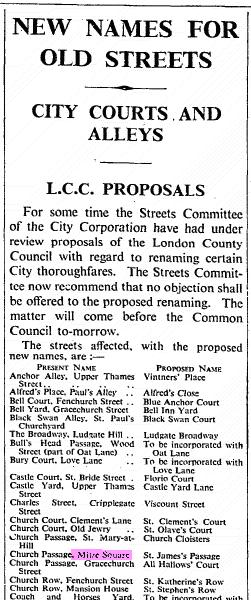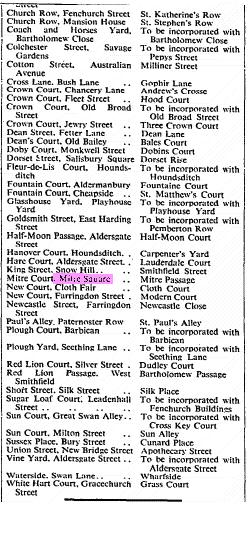
|
 |
 |
 |
 |
 |
| Author |
Message |
    
Robert Charles Linford
Assistant Commissioner
Username: Robert
Post Number: 2562
Registered: 3-2003
| | Posted on Wednesday, June 16, 2004 - 5:16 pm: |       |
I found this item in "The Times" for 19 Oct 1938, which I will try to post in two parts :
 |
    
Robert Charles Linford
Assistant Commissioner
Username: Robert
Post Number: 2563
Registered: 3-2003
| | Posted on Wednesday, June 16, 2004 - 5:25 pm: |       |

Robert |
    
Suzi Hanney
Chief Inspector
Username: Suzi
Post Number: 906
Registered: 7-2003
| | Posted on Saturday, June 26, 2004 - 11:19 am: |       |
Robert!!!
OK Sherlock!!!! this is great!!! also if you read back is Dorset St!!........to Dorset Rise!!!! Lawks!!!
Cheers
Suzi
|
    
Robert Charles Linford
Assistant Commissioner
Username: Robert
Post Number: 2617
Registered: 3-2003
| | Posted on Saturday, June 26, 2004 - 11:28 am: |       |
Hi Suzi
I don't think this was our Dorset St but another one. I think our one was by then called Duval St.
Robert |
    
Mark Andrew Pardoe
Inspector
Username: Picapica
Post Number: 246
Registered: 2-2003
| | Posted on Saturday, June 26, 2004 - 5:58 pm: |       |
Whatho all,
I wonder from where some of these names came. Why should Anchor Alley become Vintners' Place? And Cross Lane becoming Gophir Lane; next we'll have Groundhog Lane. But I like New Court changing to Modern Court, there's a bit of sense there.
I expect these name changes came about because of nearby duplications.
Cheers, Mark |
    
Jeffrey Bloomfied
Inspector
Username: Mayerling
Post Number: 403
Registered: 2-2003
| | Posted on Sunday, June 27, 2004 - 12:54 am: |       |
Hi Robert,
I noticed one name on the list of changed street nomenclature that is linked to a vicious murderer, but one earlier than Jack. Mrs. Elizabeth Brownrigg, who beat at least one apprenticed servant girl to death in 1767, lived with her husband and son in "Fleur-de-Luce" Court, which Leonard Gribble (in his QUEENS OF CRIME, a superior work of his from 1932) describes as "...a little backwater street, mainly comprised of artisans' houses, which ran between Fetter Lane and Fleet Street." The street is more properly spelled "Fleur-de-Lys Court" in Lillian de la Torre's ELIZABETH IS MISSING (New York: Alfred A. Knopf, Inc. 1945), on page 159. The name obviously relates to the "field of lilies" on the French flag that was their national flag until 1793, so the street must have been originally inhabited by French immigrants or businessmen living in London. I don't think they were Huguenots, who were not likely to want a street named for a country that so mistreated them.
This would not be the only time that a street, made notorious by a famous murder, got it's name changed. After 1953, Rillington Place got renamed. On the other hand, according to a legendary story, when the citizens of Rugeley asked permission to change their town's name after Dr. Palmer made it notorious, the sitting Prime Minister insisted it could only be done if they named it for him: Palmerston.
Best wishes,
Jeff |
    
Jeffrey Bloomfied
Inspector
Username: Mayerling
Post Number: 404
Registered: 2-2003
| | Posted on Sunday, June 27, 2004 - 1:01 am: |       |
Sorry to do a second message, but I suddenly recalled a New York City tragedy (or more correctly a Brooklyn traged) that led to a type of name change - but not a murder.
The worst subway disaster in New York City's history, occurred in November 1918 during a subway strike on what became the BMT line. A train being run by a train conductor with limited experience (who was tired) ran into a culvert just at the entrance of the Malbone Street station in Brooklyn. Nearly 100 people were killed (ironically the conductor walked away from the disaster unscratched). The street was almost totally renamed Empire Blvd., as the locals and the city wanted to forget the disaster as soon as possible (a small section of what was once Malbone Street still retains the name, but it is like a small street that goes into a dead end).
Possibly many of the streets renamed on that list that Robert put up actually have some local, grisly history that the public wanted to forget.
Jeff |
    
John Savage
Inspector
Username: Johnsavage
Post Number: 205
Registered: 2-2003
| | Posted on Sunday, June 27, 2004 - 9:32 am: |       |
Hi, Jerffrey,
Fleur-de lis Court, still exsits today, off Fetter Lane, close to Fleet Street. In the 1970's it also had a pub called "The Fleur De Lis", in which I often had partook of a liquid lunch.
Best Regards
John Savage |
    
Robert Charles Linford
Assistant Commissioner
Username: Robert
Post Number: 2620
Registered: 3-2003
| | Posted on Sunday, June 27, 2004 - 11:36 am: |       |
Hi all
This change of name business is interesting. I suppose most of it's down to duplication, notoriety, or sometimes to acknowledge a local dignitary or business enterprise (as with Brown Street/Hanbury Street).
With Buck's Row, it seems to have hung onto its old name into the 20th century, yet it was also called Durward Street as early as 1894.
Robert |
|
Use of these
message boards implies agreement and consent to our Terms of Use.
The views expressed here in no way reflect the views of the owners and
operators of Casebook: Jack the Ripper.
Our old message board content (45,000+ messages) is no longer available online, but a complete archive
is available on the Casebook At Home Edition, for 19.99 (US) plus shipping.
The "At Home" Edition works just like the real web site, but with absolutely no advertisements.
You can browse it anywhere - in the car, on the plane, on your front porch - without ever needing to hook up to
an internet connection. Click here to buy the Casebook At Home Edition.

|
 |
 |
|

